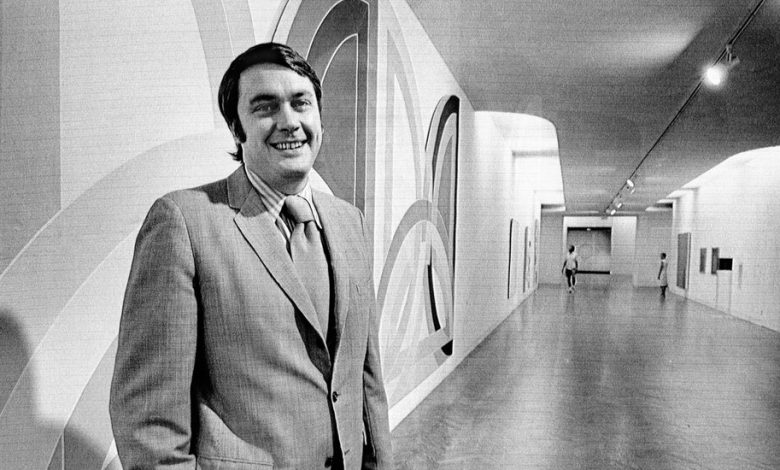William Agee, Leading Art Curator and Teacher, Dies at 86

William C. Agee was annoyed that an abstract painter he admired, Sam Francis, was sometimes not given the weight he deserved because he worked in vivid colors rather than gloomy tones.
“We have never learned how to read the language of color,” Mr. Agee told The Press Enterprise of Riverdale, Calif., in 1999, when he curated a Francis retrospective at the Geffen Contemporary at the Museum of Contemporary Art in Los Angeles. “We look at a colorful canvas and we think, ‘Oh, that’s nicely decorative canvas’ or ‘Oh, that’s so pretty.’ But we don’t take it seriously.”
Sam Francis, who died of cancer in 1994, had “been subjected to the criticism that what he is doing is vacuous, emotionally thin,” Mr. Agee told the newspaper.
“And that is entirely unfair,” he said. “You look at the last paintings that he did, after he had been diagnosed with cancer and had just lost some close friends of his, and you see him using color like a primal matter, like lava pouring out of his soul.”
That anecdote demonstrates one reason Mr. Agee was among the most respected curators, scholars and teachers in the art world, especially with regard to American Modernism.
“He was willing to challenge received ideas about artists and their work, refreshing the scholarship on them,” Pamela N. Koob, who studied under Mr. Agee as a graduate student at Hunter College and became a curator herself, wrote in a memorial.
Mr. Agee died on Dec. 24 in Middletown, Conn. He was 86.
His wife, Elita (Taylor) Agee, said the cause was pneumonia.
Mr. Agee began attracting attention as a curator in the 1960s, especially with a 1968 exhibition at the Whitney Museum of American Art of sculptural boxes and other works by Donald Judd; it was the artist’s “first major solo museum exhibition,” according to the Judd Foundation. Walter Barker, writing in The St. Louis Post-Dispatch, said that Mr. Agee “installed the show with a high degree of professionalism, and lighted it with sweep and dash.”
“He also put a catalog together that makes sense of Judd as the originator of an important concept in modern space design,” Mr. Barker added.
In 1970 Mr. Agee took his expertise to the West Coast, becoming director of exhibitions and collections at the Pasadena Art Museum in California and taking over as its director the next year. In 1974 he became director of the Museum of Fine Arts, Houston, a job he held until 1982.
In his museum jobs, and afterward as an independent curator, Mr. Agee mounted or helped mount numerous important exhibitions and wrote or contributed to their accompanying catalogs.
But Mr. Agee was equally impactful as a teacher. He joined Hunter College as a professor of Modern American art in 1990 and stayed for almost a quarter-century before retiring in 2014.
“His long curatorial experience and the insights he gained by working closely with works of art fed his teaching,” the college said in a memorial posting, “and his approach helped to center the idea of exhibition-making as a crucial aspect of art historical research.”
Ms. Koob said Mr. Agee had an inclusive style as a teacher and lecturer.
“Studying an artist or a painting with Bill could feel like a great adventure,” she said, “and he often addressed his audience as ‘we,’ implying that they were with him in the search for further understanding.”
William Cameron Agee was born on Sept. 26, 1936, in Manhattan. His father, also named William, was a lawyer, and his mother, Elsie (Burgess) Agee, was executive assistant to Anne Morgan, J.P. Morgan’s daughter.
When he was a young child, the family moved from New York City to the suburbs in Westchester County, N.Y. Mr. Agee attended Phillips Academy in Andover, Mass., where he was captain of the basketball team and, at his graduation in 1955, received the Yale Bowl prize for athletic and scholastic accomplishment.
He spent time at the school’s Addison Gallery, which has a notable collection of American art, and found his field of interest.
“That was a very important and formative experience in my life,” he said in a 1989 oral history recorded for the University of California, Los Angeles. Decades later he would assist with several exhibitions organized by the Addison or drawing on its collection.
Mr. Agee studied art history at Princeton University, earning a bachelor’s degree there in 1960. Then, after a year off to travel in Europe to get a close-up look at the art there, he earned a master’s degree in art history at Yale in 1963.
In 1964 and 1965 he directed a study for the Archives of American Art on the New Deal and the arts. In 1966 he joined the Whitney as an associate curator, where in addition to the Judd show he curated an exhibition on the Abstract Expressionist Conrad Marca-Relli.
In 1968 he moved to the Museum of Modern Art as an associate curator, spending two years there before taking the Pasadena job. He was involved in exhibitions or catalogs on Patrick Henry Bruce, Raymond Parker, Barbara Morgan, Fairfield Porter, Stuart Davis, Arthur Dove and many others, often helping to inspire a reappraisal of those artists and their importance.
“Agee brought to his work as a curator, writer and teacher a boundless love of looking,” Ann Temkin, chief curator of painting and sculpture at MoMA, said by email, “and a plain-spoken, insightful and infectiously enthusiastic way of sharing what he saw.”
In addition to his wife, whom he married in 1966, Mr. Agee is survived by a daughter, Cintra Agee; a son, Matthew; and three grandchildren. He lived in Chester, Conn.
Mr. Agee’s magnum opus was “Modern Art in America 1908-68,” published in 2016. The critic Terry Teachout, writing in The Wall Street Journal, called it “that rarity of rarities, an opinionated but not eccentric scholarly history by a veteran museum curator whose every page crackles with original thinking.”
